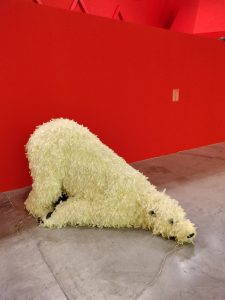Yesterday in Soundbytes – Part 1, i gave a brief overview of the art works installed on the ground floor of the Edith Russ Haus in Oldenburg (Germany) for the Soundbytes – electronic and digital soundworlds exhibition.
Let’s just get to the level below:
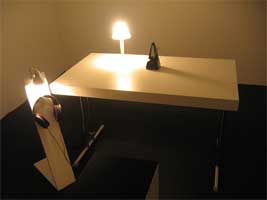
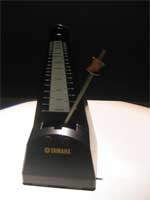 Akitsugu Maebayashi‘s Metronome Piece is one of the highlights of the show for me. The artist went for a walk around Oldenburg bringing along a metronome. The clicks produced by the instrument work as ‘sonar’ which detects information of spaces, and the echoes of tick-tick were recorded binaurally through microphones in the artist’s ears.
Akitsugu Maebayashi‘s Metronome Piece is one of the highlights of the show for me. The artist went for a walk around Oldenburg bringing along a metronome. The clicks produced by the instrument work as ‘sonar’ which detects information of spaces, and the echoes of tick-tick were recorded binaurally through microphones in the artist’s ears.
In the exhibition room, there’s a table, a chair and headphones. As you walk near the chair the light dims and you’re left with the sound of the metronome. Take the headphones and the experience becomes utterly strange. While you can still perceive the tick-tick (or people coming down the stairs above your head) coming through headphones, you’re suddenly wandering the streets of Oldenburg on the steps of Akitsugu Maebayashi. You hear people walking by and talking under the rain, a truck passing, etc. The first time i even looked behind me to check who was there (no one of course, just an audio illusion). Another layer of space and time was overlapping with what was going on around me.
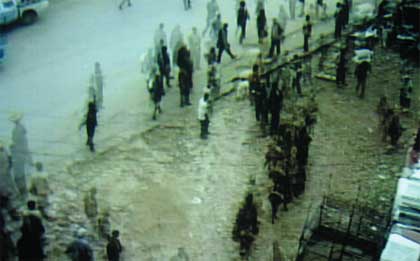 Harar (annicca), by Thomas Köner (of the Banlieu du Vide fame), is projected in the adjacent room. The work is part of the Péripheriques trilogy which shows patterns in the moves of people in the streets and detects stories in their faces. The videos were shooted in 3 different cities (Harar, Belgrade, and a favela in Buenos Aires), original sounds from the filming location blend with imaginary sounds.
Harar (annicca), by Thomas Köner (of the Banlieu du Vide fame), is projected in the adjacent room. The work is part of the Péripheriques trilogy which shows patterns in the moves of people in the streets and detects stories in their faces. The videos were shooted in 3 different cities (Harar, Belgrade, and a favela in Buenos Aires), original sounds from the filming location blend with imaginary sounds.
Annina Rüst was showing Rock ‘n’ Scroll, a sound remixing system which allows anyone to use the computer as an acoustic instrument for interventions into wifi-equipped public space. Both mobile phones and computers are connected using a VOIP software. The sound itself is a combination of standard macintosh and windows sounds, as well as sounds included in the Skype software, and pre-made drumloops. There’s also a delay effect that depend on how good the connection is.
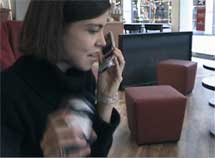
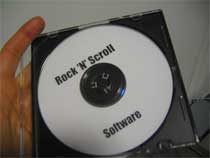
There were free softwares to take away!
The person who starts the performance has the most control (over the drum loop and the right mouse-button to turn on the microphone while turning off the rhythm.) Other participants function mainly as triggers. But no one has a total control over the whole performance.
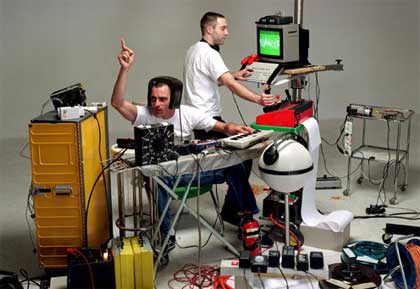
Image fluctuat
A computer was showing the website of micromusic, a low-tech music community initiated by carl (Gino Esposto), wanga (Paco Manzanares) and bacon (Michael Burkhardt), famous for their performances and compositions that use Gameboys or vintage Atari consoles. The micomusic.net website reflects their objective to build an online community where visitors can listen to and download music and chat.
There are two other projects which i like a lot but i’ll pass rapidly on them as i’ve blogged them before:
Jens Brand is showing G-Turns, the online version of the G-Players series, in an IKEA setting complete with price tags and a carpet with a wave-like pattern.
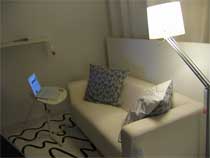
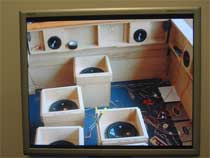
Visitor can lie in Kaffe Matthews‘ Sonic Bed and enjoy the sound properties of experimental electronic music throughout their body. There is also a video of the “making of” of the piece.
In conclusion i’d say that the exhibition is really good. There’s the fun, the loud, the introspective, the obscure, the aesthetically absorbing. It is not meant to be exhaustive but it gives an adequate overview of the many ways in which artists engage with sound materials these days. I guess i’ve been very lucky to visit the show on a quiet Thursday afternoon, i was able to enjoy each piece on my own without having to queue to be able to lay on the bed or having any sonic experience interrupted by other noises.
Flickr set.
At the Edith Russ Haus in Oldenburg, extended until April 29.
Related: Invisible Geographies: New Sound Art from Germany, an exhibition about the “physical” topography of sound at the Kitchen in New York.


